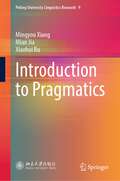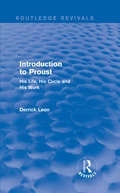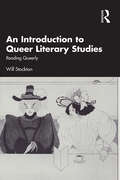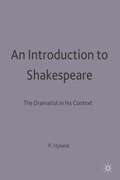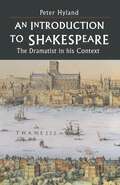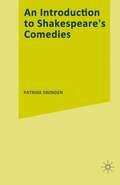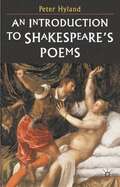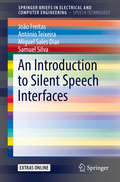- Table View
- List View
Introduction to Pragmatics (Blackwell Textbooks in Linguistics)
by Betty J. BirnerIntroduction to Pragmatics guides students through traditional and new approaches in the field, focusing particularly on phenomena at the elusive semantics/pragmatics boundary to explore the role of context in linguistic communication. Offers students an accessible introduction and an up-to-date survey of the field, encompassing both established and new approaches to pragmatics Addresses the traditional range of topics – such as implicature, reference, presupposition, and speech acts – as well as newer areas of research, including neo-Gricean theories, Relevance Theory, information structure, inference, and dynamic approaches to meaning Explores the relationship and boundaries between semantics and pragmatics Ideal for students coming to pragmatics for the first time
Introduction to Pragmatics (Peking University Linguistics Research #9)
by Mingyou Xiang Mian Jia Xiaohui BuThis book covers major topics in the Anglo-American tradition, including deixis, presupposition, implicature, speech acts, and (im)politeness. These key topics are illustrated with examples and case studies from various contexts such as romantic relationships, online forums, social media posts, and popular culture. The book also includes a methods chapter that offers a hands-on guide for literature search, data collection, and data analysis. This book is particularly suitable for readers who have no prior knowledge of pragmatics.
Introduction to Proust: His Life, His Circle and His Work (Routledge Revivals)
by Derrick LeonThis book, first published in 1940, provides an introduction to the life and work of the French novelist, critic, and essayist Marcel Proust, who is considered by many to be one of the greatest authors of all time. This book will be of interest to students of literature.
Introduction to Proust: His Life, His Circle and His Work (Routledge Revivals)
by Derrick LeonThis book, first published in 1940, provides an introduction to the life and work of the French novelist, critic, and essayist Marcel Proust, who is considered by many to be one of the greatest authors of all time. This book will be of interest to students of literature.
An Introduction to Psycholinguistics
by Danny D. Steinberg Natalia V. SciariniLearning About Language is an exciting and ambitious series of introductions to fundamental topics in language, linguistics and related areas. The books are designed for students of linguistics and those who are studying language as part of a wider course. Cognitive Linguistics explores the idea that language reflects our experience of the world. It shows that our ability to use language is closely related to other cognitive abilities such as categorization, perception, memory and attention allocation. Concepts and mental images expressed and evoked by linguistic means are linked by conceptual metaphors and metonymies and merged into more comprehensive cognitive and cultural models, frames or scenarios. It is only against this background that human communication makes sense. After 25 years of intensive research, cognitive-linguistic thinking now holds a firm place both in the wider linguistic and the cognitive-science communities.An Introduction to Cognitive Linguistics carefully explains the central concepts of categorizaÂtion, of prototype and gestalt perception, of basic level and conceptual hierarchies, of figure and ground, and of metaphor and metonymy, for which an innovative description is provided. It also brings together issues such as iconicity, lexical change, grammaticalization and language teaching that have profited considerably from being put on a cognitive basis.The second edition of this popular introduction provides a comprehensive and accessible up-to-date overview of Cognitive Linguistics: Clarifies the basic notions supported by new evidence and examples for their application in language learning Discusses major recent developments in the field: the increasing attention paid to metonymies, Construction Grammar, Conceptual Blending and its role in online-processing. Explores links with neighbouring fields like Relevance Theory Uses many diagrams and illustrations to make the theoretical argument more tangible Includes extended exercises Provides substantial updated suggestions for further reading.
An Introduction to Psycholinguistics
by Danny D. Steinberg Natalia V. SciariniLearning About Language is an exciting and ambitious series of introductions to fundamental topics in language, linguistics and related areas. The books are designed for students of linguistics and those who are studying language as part of a wider course. Cognitive Linguistics explores the idea that language reflects our experience of the world. It shows that our ability to use language is closely related to other cognitive abilities such as categorization, perception, memory and attention allocation. Concepts and mental images expressed and evoked by linguistic means are linked by conceptual metaphors and metonymies and merged into more comprehensive cognitive and cultural models, frames or scenarios. It is only against this background that human communication makes sense. After 25 years of intensive research, cognitive-linguistic thinking now holds a firm place both in the wider linguistic and the cognitive-science communities.An Introduction to Cognitive Linguistics carefully explains the central concepts of categorizaÂtion, of prototype and gestalt perception, of basic level and conceptual hierarchies, of figure and ground, and of metaphor and metonymy, for which an innovative description is provided. It also brings together issues such as iconicity, lexical change, grammaticalization and language teaching that have profited considerably from being put on a cognitive basis.The second edition of this popular introduction provides a comprehensive and accessible up-to-date overview of Cognitive Linguistics: Clarifies the basic notions supported by new evidence and examples for their application in language learning Discusses major recent developments in the field: the increasing attention paid to metonymies, Construction Grammar, Conceptual Blending and its role in online-processing. Explores links with neighbouring fields like Relevance Theory Uses many diagrams and illustrations to make the theoretical argument more tangible Includes extended exercises Provides substantial updated suggestions for further reading.
Introduction to Psycholinguistics: Understanding Language Science
by Matthew J. TraxlerThe new edition of the popular introduction to the field of psycholinguistics, providing a solid foundation for understanding how people produce and comprehend language Introduction to Psycholinguistics: Understanding Language Science, Second Edition, presents a comprehensive overview of the cognitive processes involved in language acquisition, production, and comprehension. Balancing depth and accessibility, this bestselling textbook adopts a multidisciplinary approach to the study of language that incorporates perspectives from psychology, linguistics, philosophy, computer science, neurology, neurophysiology, and related fields. Student-friendly chapters explain the core components of speech, discuss how the brain receives and applies the basic building blocks of language, review leading research in psycholinguistics, describe the experimental evidence behind major theories, and more. Fully updated to incorporate recent developments in the field, the second edition of Introduction to Psycholinguistics includes a new section devoted to language and cognitive disorders, two entirely new chapters on language as aspects of autism and schizophrenia, updated illustrations and learning objectives, and new coverage of language acquisition, the cognitive neuroscience of language, bilingualism, and sign language. This valuable textbook: Reviews leading research and theory in psycholinguistics, including in-depth descriptions of the experimental evidence behind theories Describes phonology, morphology, semantics, syntax, pragmatics, and other key components of language Covers bilingualism, second-language acquisition, sign language comprehension, reading comprehension, and non-literal language interpretation Discusses cognitive disorders such as autism, aphasia, schizophrenia, and specific language impairment (SLI) Offers clear learning objectives, engaging thought exercises, chapter review questions, and step-by-step explanations of all key concepts Provides resources for instructors and students, including a companion website with review exercises, quizzes, PowerPoint slides, test banks, and other supplementary materials Introduction to Psycholinguistics: Understanding Language Science, Second Edition, is an excellent textbook for upper-level undergraduate courses in psycholinguistics, language processing, and cognitive or communication disorders, as well as related courses in psychology, linguistics, cognitive science, neuroscience, language education, and computational linguistics.
Introduction to Psycholinguistics: Understanding Language Science
by Matthew J. TraxlerThe new edition of the popular introduction to the field of psycholinguistics, providing a solid foundation for understanding how people produce and comprehend language Introduction to Psycholinguistics: Understanding Language Science, Second Edition, presents a comprehensive overview of the cognitive processes involved in language acquisition, production, and comprehension. Balancing depth and accessibility, this bestselling textbook adopts a multidisciplinary approach to the study of language that incorporates perspectives from psychology, linguistics, philosophy, computer science, neurology, neurophysiology, and related fields. Student-friendly chapters explain the core components of speech, discuss how the brain receives and applies the basic building blocks of language, review leading research in psycholinguistics, describe the experimental evidence behind major theories, and more. Fully updated to incorporate recent developments in the field, the second edition of Introduction to Psycholinguistics includes a new section devoted to language and cognitive disorders, two entirely new chapters on language as aspects of autism and schizophrenia, updated illustrations and learning objectives, and new coverage of language acquisition, the cognitive neuroscience of language, bilingualism, and sign language. This valuable textbook: Reviews leading research and theory in psycholinguistics, including in-depth descriptions of the experimental evidence behind theories Describes phonology, morphology, semantics, syntax, pragmatics, and other key components of language Covers bilingualism, second-language acquisition, sign language comprehension, reading comprehension, and non-literal language interpretation Discusses cognitive disorders such as autism, aphasia, schizophrenia, and specific language impairment (SLI) Offers clear learning objectives, engaging thought exercises, chapter review questions, and step-by-step explanations of all key concepts Provides resources for instructors and students, including a companion website with review exercises, quizzes, PowerPoint slides, test banks, and other supplementary materials Introduction to Psycholinguistics: Understanding Language Science, Second Edition, is an excellent textbook for upper-level undergraduate courses in psycholinguistics, language processing, and cognitive or communication disorders, as well as related courses in psychology, linguistics, cognitive science, neuroscience, language education, and computational linguistics.
An Introduction to Quantitative Text Analysis for Linguistics: Reproducible Research Using R
by Jerid FrancomAn Introduction to Quantitative Text Analysis for Linguistics: Reproducible Research Using R is a pragmatic textbook that equips students and researchers with the essential concepts and practical programming skills needed to conduct quantitative text analysis in a reproducible manner. Designed for undergraduate students and those new to the field, this book assumes no prior experience with statistics or programming, making it an accessible resource for anyone embarking on their journey into quantitative text analysis.Through a pedagogical approach which emphasizes intuitive understanding over technical details, readers will gain data literacy by learning to identify, interpret, and evaluate data analysis procedures and results. They will also develop research skills, enabling them to design, implement, and communicate quantitative text analysis projects effectively. The book places a strong emphasis on programming skills, guiding readers through interactive lessons, tutorials, and lab activities using the R programming language and real-world datasets.This practical textbook is enriched with features that facilitate learning, including thought and practical exercises, a companion website that includes programming demonstrations to develop and augment readers’ recognition of how programming strategies are implemented, and a GitHub repository that contains both a set of interactive R programming lessons and lab exercises, which guide readers through practical hands-on programming applications. This textbook is an essential companion to any linguist looking to learn how to incorporate quantitative data analysis into their work.The Open Access version of this book, available at http://www.taylorfrancis.com, has been made available under a Creative Commons Attribution-Non Commercial-No Derivatives (CC-BY-NC-ND) 4.0 license.
An Introduction to Quantitative Text Analysis for Linguistics: Reproducible Research Using R
by Jerid FrancomAn Introduction to Quantitative Text Analysis for Linguistics: Reproducible Research Using R is a pragmatic textbook that equips students and researchers with the essential concepts and practical programming skills needed to conduct quantitative text analysis in a reproducible manner. Designed for undergraduate students and those new to the field, this book assumes no prior experience with statistics or programming, making it an accessible resource for anyone embarking on their journey into quantitative text analysis.Through a pedagogical approach which emphasizes intuitive understanding over technical details, readers will gain data literacy by learning to identify, interpret, and evaluate data analysis procedures and results. They will also develop research skills, enabling them to design, implement, and communicate quantitative text analysis projects effectively. The book places a strong emphasis on programming skills, guiding readers through interactive lessons, tutorials, and lab activities using the R programming language and real-world datasets.This practical textbook is enriched with features that facilitate learning, including thought and practical exercises, a companion website that includes programming demonstrations to develop and augment readers’ recognition of how programming strategies are implemented, and a GitHub repository that contains both a set of interactive R programming lessons and lab exercises, which guide readers through practical hands-on programming applications. This textbook is an essential companion to any linguist looking to learn how to incorporate quantitative data analysis into their work.The Open Access version of this book, available at http://www.taylorfrancis.com, has been made available under a Creative Commons Attribution-Non Commercial-No Derivatives (CC-BY-NC-ND) 4.0 license.
An Introduction to Queer Literary Studies: Reading Queerly
by Will StocktonAn Introduction to Queer Literary Studies: Reading Queerly is the first introduction to queer theory written especially for students of literature. Tracking the emergence of queer theory out of gay and lesbian studies, this book pays unique attention to how queer scholars have read some of the most well-known works in the English language. Organized thematically, this book explores queer theoretical treatments of sexual identity, gender and sexual norms and normativity, negativity and utopianism, economics and neoliberalism, and AIDS activism and disability. Each chapter expounds upon foundational works in queer theory by scholars including Michel Foucault, Eve Kosofsky Sedgwick, and Lee Edelman. Each chapter also offers readings of primary texts –ranging from the highly canonical, like John Milton’s Paradise Lost, to more contemporary works of popular fiction, like Stephen King’s ’Salem’s Lot. Along the way, An Introduction to Queer Literary Studies: Reading Queerly demonstrates how queer reading methods work alongside other methods like feminism, historicism, deconstruction, and psychoanalysis. By modelling queer readings, this book invites literature students to develop queer readings of their own. It also suggests that reading queerly is not simply a matter of reading work written by queer people. Queer reading attunes us to the queerness of even the most straightforward text.
An Introduction to Queer Literary Studies: Reading Queerly
by Will StocktonAn Introduction to Queer Literary Studies: Reading Queerly is the first introduction to queer theory written especially for students of literature. Tracking the emergence of queer theory out of gay and lesbian studies, this book pays unique attention to how queer scholars have read some of the most well-known works in the English language. Organized thematically, this book explores queer theoretical treatments of sexual identity, gender and sexual norms and normativity, negativity and utopianism, economics and neoliberalism, and AIDS activism and disability. Each chapter expounds upon foundational works in queer theory by scholars including Michel Foucault, Eve Kosofsky Sedgwick, and Lee Edelman. Each chapter also offers readings of primary texts –ranging from the highly canonical, like John Milton’s Paradise Lost, to more contemporary works of popular fiction, like Stephen King’s ’Salem’s Lot. Along the way, An Introduction to Queer Literary Studies: Reading Queerly demonstrates how queer reading methods work alongside other methods like feminism, historicism, deconstruction, and psychoanalysis. By modelling queer readings, this book invites literature students to develop queer readings of their own. It also suggests that reading queerly is not simply a matter of reading work written by queer people. Queer reading attunes us to the queerness of even the most straightforward text.
An Introduction to Regional Englishes: Dialect Variation in England (Edinburgh Textbooks on the English Language)
by Joan BealA description of regional varieties of British English, along with discussion of current research in dialectology/ variationist sociolinguistics.
An Introduction to Regional Englishes: Dialect Variation in England (Edinburgh Textbooks on the English Language)
by Joan C BealAre the dialects of England disappearing in the wake of globalisation and ‘Estuary English’, or are geographical differences as strong as ever? Joan Beal looks at recent research into regional variation in England, discusses the evidence for ‘dialect levelling’ and argues that, despite this, features of dialect are still clear markers of regional and local identity. Chapters outlining the main regional differences in accent, dialect grammar and dialect vocabulary are followed by discussions of research into geographical diffusion, levelling, issues of identity and stereotypes. Each chapter is accompanied by either an exercise based on data provided, a data-gathering exercise using methodological tools provided, or an extract from a media article provided to provoke discussion. The book also includes a guide to resources available for the study of regional dialects in England. Features: * An up-to-date account of research into regional variation in England * A practical, ‘hands on’ approach, providing the reader with the methods and resources to carry out research projects * Includes exercises for use in class.
An Introduction to Religion and Literature
by Mark KnightReligion has always been an integral part of the literary tradition: many canonical and non-canonical texts engage extensively with religious ideas, and the development of English Literature as a professional discipline began with an explicit consideration of the relationship between religion and literature. Literature also plays an important role in religious writing, as twentieth-century work on narrative theology has acknowledged. Both the recent theological turn of literary theory and the renewed political significance of religious debate in contemporary western culture have generated further interest in this interdisciplinary area. An Introduction to Religion and Literature offers a lucid, accessible and thoughtful introduction to the study of religion and literature. While the focus is on Christian theology and post-1800 British literature, substantial reference is made to earlier writers, texts from North America and mainland Europe, and other faith positions. Each chapter takes up a major theological idea and explores it through close readings of well-known and influential literary texts.
An Introduction to Religious Language: Exploring Theolinguistics in Contemporary Contexts
by Valerie HobbsReligious language is all around us, embedded in advertising, politics and news media. This book introduces readers to the field of theolinguistics, the study of religious language. Investigating the ways in which people talk to and about God, about the sacred and about religion itself, it considers why people make certain linguistic choices and what they accomplish.Introducing the key methods required for examining religious language, Valerie Hobbs acquaints readers with the most common and important theolinguistic features and their functions. Using critical corpus-assisted discourse analysis with a focus on archaic and other lexical features, metaphor, agency and intertextuality, she examines religious language in context. Highlighting its use in both expected locations, such as modern-day prayer and politics, and unexpected locations including advertising, sport, healthcare and news media, Hobbs analyses the shifting and porous linguistic boundaries between the religious and the secular. With discussion questions and lists of further readings for each chapter, and a companion website featuring video excerpts, tools for corpus research and links to archives, this is the ideal introduction to the study of religious language.
An Introduction to Rhetorical Communication
by James C MccroskeyAn Introduction to Rhetorical Communication offers a true integration of rhetorical theory and social science approaches to public communication. This highly successful text guides students through message planning and presentation in an easy step-by-step process. An Introduction to Rhetorical Communication provides students with a solid grounding in the rhetorical tradition and the basis for developing effective messages.
An Introduction to Rhetorical Communication
by James C MccroskeyAn Introduction to Rhetorical Communication offers a true integration of rhetorical theory and social science approaches to public communication. This highly successful text guides students through message planning and presentation in an easy step-by-step process. An Introduction to Rhetorical Communication provides students with a solid grounding in the rhetorical tradition and the basis for developing effective messages.
An Introduction to Second Language Acquisition Research
by Diane Larsen-Freeman Michael H. LongUnderstanding how people learn and fail to learn second and foreign languages is increasingly recognised as a critical social and psycholinguistic issue. Second languages are vitally important to diverse groups of people, ranging from refugees to college students facing foreign language requirements. This book provides a synthesis of empirical findings on second and foreign language learning by children and adults, emphasising the design and execution of appropriate research.
An Introduction to Second Language Acquisition Research
by Diane Larsen-Freeman Michael H. LongUnderstanding how people learn and fail to learn second and foreign languages is increasingly recognised as a critical social and psycholinguistic issue. Second languages are vitally important to diverse groups of people, ranging from refugees to college students facing foreign language requirements. This book provides a synthesis of empirical findings on second and foreign language learning by children and adults, emphasising the design and execution of appropriate research.
An Introduction to Shakespeare: The Dramatist in His Context
by Peter HylandPeter Hyland provides a highly readable account of the historical, social and political pressures of Shakespeare's England and the material conditions under which his plays were written, including a comprehensive description of the development and status of the theatrical profession. Half of the book is given over to a survey of the plays and examines numerous controversial issues that arise when we ask precisely what we can 'know' about them. For those who are daunted by the volume or the impenetrable prose of much recent writing on Shakespeare, Hyland's book will be a stimulating introduction.
An Introduction to Shakespeare: The Dramatist in His Context
by Peter HylandPeter Hyland provides a highly readable account of the historical, social and political pressures of Shakespeare's England and the material conditions under which his plays were written, including a comprehensive description of the development and status of the theatrical profession. Half of the book is given over to a survey of the plays and examines numerous controversial issues that arise when we ask precisely what we can 'know' about them. For those who are daunted by the volume or the impenetrable prose of much recent writing on Shakespeare, Hyland's book will be a stimulating introduction.
An Introduction to Shakespeare's Poems
by Peter HylandAn Introduction to Shakespeare's Poems provides a lively and informed examination of Shakespeare's non-dramatic poetry: the narrative poems Venus and Adonis and The Rape of Lucrece; the Sonnets; and various minor poems, including some only recently attributed to Shakespeare. Peter Hyland locates Shakespeare as a sceptical voice within the turbulent social context in which Elizabethan professional poets had to work, and relates his poems to the tastes, values and political pressures of his time. Hyland also explores how Shakespeare's poetry can be of interest to twenty-first century readers.
An Introduction to Silent Speech Interfaces (SpringerBriefs in Speech Technology)
by João Freitas António Teixeira Miguel Sales Dias Samuel SilvaThis book provides a broad and comprehensive overview of the existing technical approaches in the area of silent speech interfaces (SSI), both in theory and in application. Each technique is described in the context of the human speech production process, allowing the reader to clearly understand the principles behind SSI in general and across different methods. Additionally, the book explores the combined use of different data sources, collected from various sensors, in order to tackle the limitations of simpler SSI approaches, addressing current challenges of this field. The book also provides information about existing SSI applications, resources and a simple tutorial on how to build an SSI.

